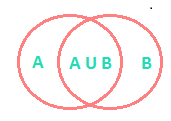Notations:-
∈ → belongs to
∉ → does not belongs to
⊆ → is a subset of
⊇ → is a superset of
⊂ → is a proper subset of
∀ → for all/ for every/ for each
∃ → there exists (at least one)
(i) Union of sets: Given ‘n’ sets n 2, then the set formed by taking all the elements of each of the n-sets as its element as its elements is called union of n-sets
The union of two sets A, B is denoted by A ∪ B and defined as A ∪ B = {x| x ϵ A V x ϵ B} or \(\bigcup\limits_{i=1}^{n}{{{A}_{i}}}\).
⇒ \(\bigcup\limits_{i=1}^{n}{{{A}_{i}}}\) = {x| x ϵ at least one of sets A1, A2, — An} Note: – Every set is a subset of itself
Note: – Every set is a subset of itself
(ii) Null set is subset of every set:
A ⊆ A ∪ B, B ⊆ A ∪ B
If A, B are infinite disjoint sets |A ∪ B| = | A | + | B |
∩ | A ∪ B | = ∩ (A) + ∩ (B) In general, N sets A1, A2, …, An are finite pair wise defined as \(\left| \bigcup\limits_{i=1}^{n}{{{A}_{i}}} \right|=\sum\limits_{i=1}^{n}{\left| Ai \right|}\).
In general, N sets A1, A2, …, An are finite pair wise defined as \(\left| \bigcup\limits_{i=1}^{n}{{{A}_{i}}} \right|=\sum\limits_{i=1}^{n}{\left| Ai \right|}\).
Properties of union of sets:
⇒ A ∪ A = A … {Idempotent law under union}
⇒ A ∪ B = B ∪ A … {Commutative}
⇒ A ∪ B ∪ C = (A ∪B) ∪ C = A ∪ (B ∪ C) … (associative)
